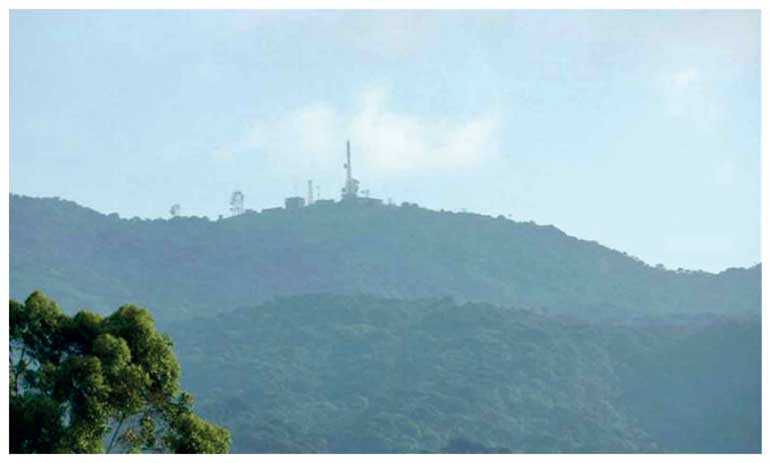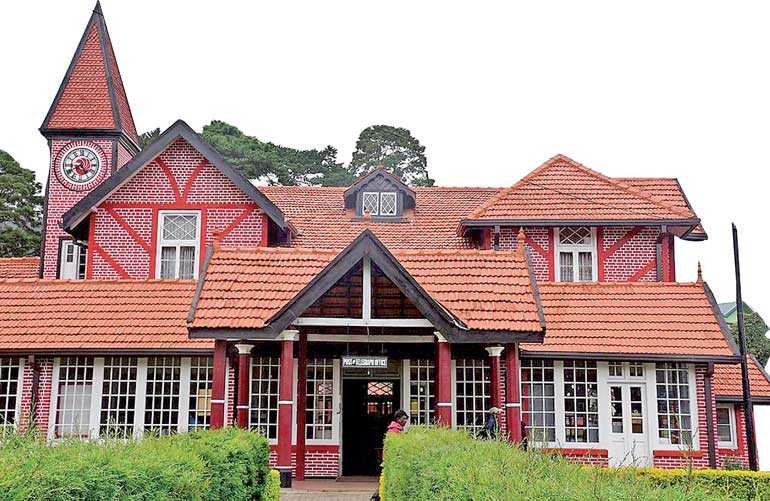Monday Dec 15, 2025
Monday Dec 15, 2025
Saturday, 13 October 2018 00:10 - - {{hitsCtrl.values.hits}}

View of Pidurutalagala with radio equipment seen at a distance
By D.C. Ranatunga
Reading the news item about the setting up of a post box at the summit of Pidurutagala, the highest mountain in Sri Lanka (height of 2,524 metres), brought back memories of the trips we did as undergrads in the Peradeniya campus in the mid-1950s. Apparently now you can drive up to the top. When we went we had to trudge along a walk path for about four miles. It was not a steep climb but a very pleasant one through greenery amidst trees and bushes. Going in a crowd it was a real joyful walk.
Judging by the decision of the postal authorities to set up a post box at the summit there is obviously a demand for it. It is for the convenience of the overseas visitors who would want to send a picture postcard to their contacts back in the home country. According to the news item cards and stamps are available at the army welfare shop at the summit.
The Nuwara Eliya post office, the closest to the mountain, would have been prompted to set up a post box noting that a fair amount of tourists are used to the habit of posting cards after visiting the summit. The collection of material is to be done on a daily basis using the Army vehicle going up and down once a day. A thoughtful idea by the postmaster of NE Post Office, W.N.C.K. Vidurapola thinking out of the box – a habit which most public officials are not used to.
Records indicate that as early as 1897, there were paths to climb the mountain by foot in two-and-a-half-hours or in a shorter time by horseback. For the benefit of females there had been the facility where two persons carried them in a chair placed on two wooden bamboos.
The mountain had been called ‘Mount Pedro’ from British times as pronouncing ‘Pidurutalagala’ would have been difficult for the foreigners.
Discussing places to visit in his book ‘Ceylon along the Rail Track’ (1910), Henry W Cave writes a fascinating account of his experience in climbing to the summit, 8,300 feet above sea level.
“The ascent is easy and the reward is great,” is how he starts. “From no other mountain top in the world can you literally see over a whole island of such extent and beauty as from this. From shore to shore lie outstretched in every direction forests and plains, mountain ranges interlaced in intricate confusion, masses of verdant patana lands, interspersed with glittering streams; while the stillness of the profound solitude is broken only by the sounds from mountain torrents in their wild rush over the huge boulders in the rocky ravines. It is here, with the accumulated impressions of the whole journey from the coast to the highest point of the highlands fresh in his mind, that the traveller confers on Ceylon the title of ‘the show place of the universe’.”
He found the journey to the top to be about four miles – a very good two hours’ walk. Overwhelmed by the beautiful scene which heralds the approach of day, he writes: “To stand up at the highest point of this sea-girt land, with the shadowed sky above and brooding darkness below, there to watch the rosy-fingered dawn cast her first rays upon the thousand peaks that begin to peep through the snowy mists which yet enshroud the low-lying valleys, is an experience well worth the surrender of a few hours of sleep and an occasional fright at midnight forest sounds which betoken the proximity of some denizen of the jungle.
“The first glimmer of light reveals snowy masses of mist as far as the eye can scan, right away to the ocean east and west, with lighted peaks peering through the veil resembling laughing islands doting a sea of foam. Then as the dawn breaks a golden tint gradually appears over the hills, and when the sun bursts over the horizon a rapid transformation takes place. The petrified surf of the mists now begins to move upwards, and reveals with vivid clearness the valleys all fresh from their repose. The dewy leaves of the forest trees and the trails of beautiful moss which cling to their branches glisten with tints of gold, the moistened rocks sparkle with diamonds, and all nature rejoices at the new-born day.
“As the sun rises higher the nearer slopes become more distinct, and the distant ranges are clearly visible right away to Adam’s Peak. The intermediate range of the Great Western (7,264 feet), five miles west of Nuwara Eliya, and Talankanda range (6,137 feet), dividing the tea-growing districts of Dibula and Dickoya, are seen most clearly as the sun gains power.
“Nuwara Eliya is lying at our feet. The whole plain glistens with hoar forest or sparkling dew, the river, like a silver streak, winds its course to the Hakgalla gorge, and for a great distance ranges of forest-clad mountains alternate with waving plains. The nearest range is called One Tree Hill, then comes the Elk Plains range, the next is a mountain of the Agrapatana district, and the lofty range in the distance is that of Horton Plains. The tops of all these ranges are clothed with forests, while rolling patanas cover the ridges between.”

Nuwara Eliya post office – the iconic red-brick building built in 1894